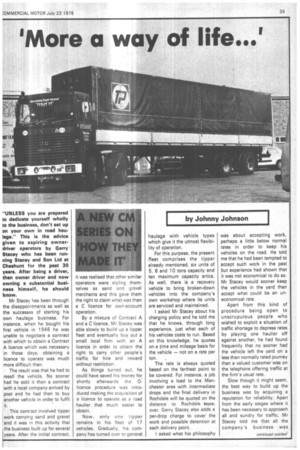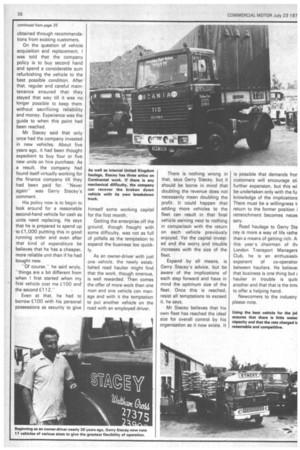'More a way of life...
Page 37

Page 38

If you've noticed an error in this article please click here to report it so we can fix it.
by Johnny Johnson
-UNLESS you are prepared to dedicate yourself wholly to the business, don't set up on your own in road haulage." This is the advice given to aspiring ownerdriver operators by Gerry ' Stacey who has been running Stacey and Son Ltd at Cheshunt for the past 30 years. After being a driver, then owner driver and now owning a substantial business himself, he should know.
Mr Stacey has been through the disappointments as well as the successes of starting his own haulage business. For instance, when he bought his first vehicle in 1946 he was unable to negotiate a contract with which to obtain a Contract A licence which was necessary in those days; obtaining a licence to operate was much more difficult then, The result was that he had to resell the vehicle. No sooner had he sold it than a contract with a local company arrived by post and he had then to buy another vehicle in order to fulfil it.
This contract involved tipper work carrying sand and gravel and it was In this activity that the business built up for several years. After the initial contract, it was realised that other similar operators were styling themselves as sand and gravel merchants and this gave them the right to claim what was then a C licence for own-account operation.
By a mixture of Contract A and a C licence, Mr Stacey was able slowly to build up a tipper fleet and eventually buy out a small local firm with an A licence in order to obtain the right to carry other people's traffic for hire and reward without restriction.
As things turned out, he could have saved his money for shortly afterwards the 0licence procedure was introduced making the acquisition of a licence to operate as a road haulier that much easier to obtain.
Now, only one tipper remains in his fleet of 17 vehicles. Gradually, his company has turned over to general haulage with vehicle types which give it the utmost flexibility of operation.
For this purpose, the present fleet comprises the tipper already mentioned, six units of 5, 6 and 10 tons capacity and ten maximum capacity artics. As well, there is a recovery vehicle to bring broken-down Nehicles into the company's own workshop where its units are serviced and maintained.
I asked Mr Stacey about his charging policy and he told me that he knows, through long experience, just what each of his vehicles costs to run. Based on this knowledge, he quotes on a time and mileage basis for the vehicle — not on a rate per ton.
The rate is always quoted based on the farthest point to be covered. For instance, a job involving a load to the Manchester area with intermediate drops and the final delivery in Rochdale will be quoted on the distance to Rochdale. mere: over, Gerry. Stacey. also adds a per-drop charge to cover the work and possible detention at each delivery point.
I asked what his philosophy
was about accepting work, perhaps a little below normal rates in order to keep his vehicles on the road. He told me that he had been tempted to accept such work in the past but experience had shown that it was not economical to do so. Mr Stacey would sooner keep the vehicles in the yard than accept what could be an uneconomical rate.
Apart from this kind of procedure being open to unscrupulous people who wished to exploit a situation of, traffic shortage to depress rates by playing one haulier off against another, he had found frequently that no sooner had the vehicle left the yard on a less than normally rated journey than a valued customer was on the telephone offering traffic at the firm's usual rate.
Slow though it might seem, the best way to build up the business was by acquiring a reputation for reliability. Apart from the early stages where it has been necessary to approach all and sundry for traffic, Mr Stacey told me that all the company's business was obtained through recommendations from existing customers.
On the question of vehicle acquisition and replacement, I was told that the company policy is to buy second hand and spend a considerable sum refurbishing the vehicle to the best possible condition. After that, regular and careful maintenance ensured that they stayed that way till it was no longer possible to keep them without sacrificing reliability and money. Experience was the guide to when this point had been reached.
Mr Stacey said that only once had the company invested in new vehicles. About five years .ago, it had been thought expedient to buy four or five new units on hire purchase. As a result, the company had found itself virtually working for the finance company till they had been paid for. "Never again" was Gerry Stacey's comment.
His policy now is to begin to look around for a reasonable second-hand vehicle for cash as units need replacing. He says that he is prepared to spend up to CLOD() puttting this in good running order and even after that kind of expenditure be believes that he has a cheaper-, more reliable unit than if he had bought new.
"Of course," he said wryly, "things are a bit different from when I first started when my first vehicle cost me CI 00 and the second El 1 2."
Even at that, he had to borrow £100 with his personal possessions as security to give himself some working capital for the first month.
Getting the enterprise off the ground, though fraught with some difficulty, was not as full of pitfalls as the temptation to expand the business too quickly.
As an owner-driver with just one. vehicle, the newly established road haulier might find that the work, though onerous, is well rewarded. Then comes the offer of more work than one man and one vehicle can manage and with it the temptation to put another vehicle on the road with an employed driver. There is nothing wrong in that, says Gerry Stacey, but it should be borne in mind that doubling the revenue does not necessarily mean doubling the profit. It could happen that adding more vehicles to the fleet can result in that final vehicle earning next to nothing in comparison with the return on each vehicle previously enjoyed. Yet the capital invested and the worry and trouble increases with the size of the fleet.
Expand by all means, is Gerry Stacey's advice, but be aware of the implications of each step forward and have in mind the optimum size of the fleet. Once this is reached, resist all temptations to exceed it, he says.
• Mr Stacey believes that his own fleet has reached the ideal size for overall control by his organisation as it now exists. It is possible that demands fror customers will encourage sti further expansion, but this wi be undertaken only with the fu knowledge of the implications There must be a willingness ti return to the former position i retrenchment becomes neces sary.
Road haulage to Gerry Sta cey is more a way of life rathe than a means of getting rich. A: this year's chairman of thi London Transport Managers Club, he is an enthusiastii exponent of co-operatior between hauliers. He believe that business is one thing but ( haulier in trouble is quite another and that that is the tim( to offer a helping hand.
Newcomers to the industry please note.
















































































































